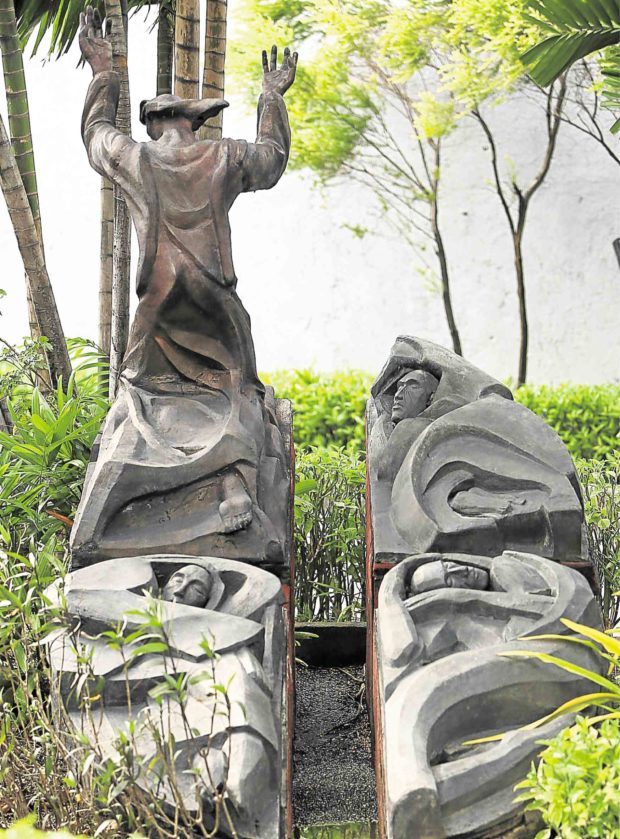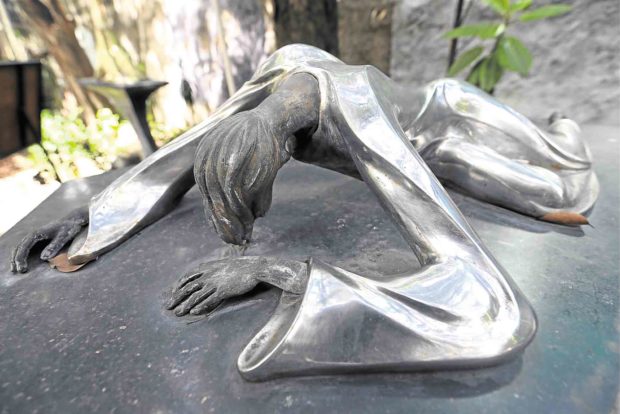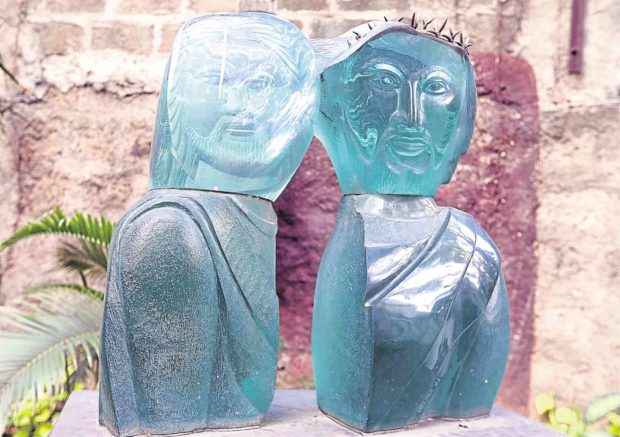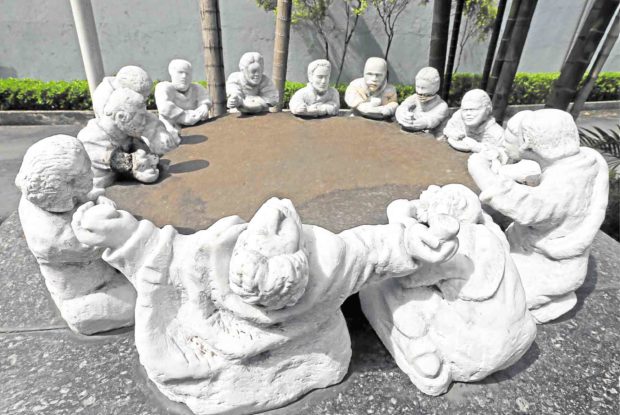Makati church treasure: A garden of art and agony
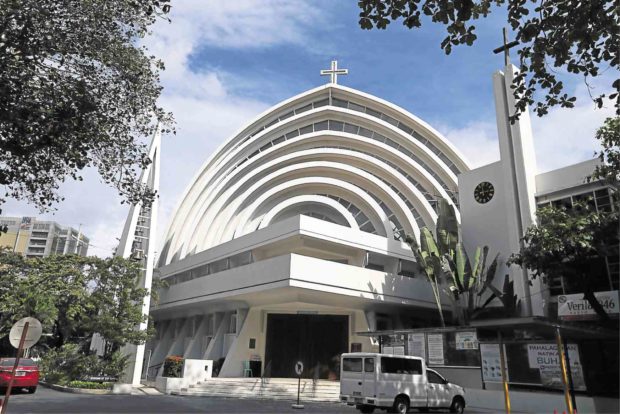
Within the Magallanes Church compound in Makati City is a collection of glass, stone and metal sculptures by a virtual Who’s Who of contemporary Philippine art, depicting the passion, death and resurrection of Jesus Christ. The parish has initiated efforts to restore damaged art works and improve the garden where they can be viewed especially during Lent.—PHOTOS BY EDWIN BACASMAS
This treasure trove of sculptures, tucked away in a church in Makati City, can be considered a holy trinity in itself: a consummate display of craftsmanship, a tactile portrayal of Christ’s passion, and a profound expression of faith.
Despite being kept in a garden along one of the country’s busiest thoroughfares, its existence is practically unknown outside the local community.
The 16-year-old collection is the distinctive take of Magallanes Church on the Way of the Cross, the 14-step Catholic devotion that recounts the suffering of Christ on the day of his death.
Typically observed on Fridays during Lent, the ritual takes pilgrims through His final hours, taking pause at each station for prayer and reflection.
At Magallanes Church, which is formally known as St. Alphonsus Mary de Liguori Parish, the stations feature masterpieces by a virtual Who’s Who of contemporary Philippine art.
“Each work is a unique moment of grace, because it is imbued with all the thought, passion and fervor of a specific artist really putting himself into his work,” said architect Dominic Galicia, who designed the last station, a marble and black granite interpretation of the Resurrection.
“Gathering them, you have a kind of trail of grace, with each work expressing a unique moment in Christ’s life. It’s uniqueness upon uniqueness,” he added.
The works were pooled together by one of the parishioners, 2006 National Artist for Architecture Ildefonso Santos Jr., who also designed the curvilinear garden where the sculptures can be found. (Built in 1969, the church itself was originally designed by another National Artist, Leandro Locsin.)
Abueva, Orlina, Castrillo
The stations include the Last Supper by Napoleon Abueva, a National Artist awardee in 1976 and hailed as the father of modern Philippine sculpture.
Abueva’s creation in stone is now imbued with more poignancy; the master passed away on Friday at the age of 88.
There’s also the chunk glass depiction of the encounter between Christ and Simon of Cyrene on the way to Calvary, as rendered by the renowned Ramon Orlina.
At the 12th station is a bronze Jesus nailed to the cross, fashioned by Eduardo Castrillo, the man behind the Edsa People Power Monument.
All but one of the works were commissioned by the parishioners and donated to the church. The scene at the 11th station, a metal tableau of Mother Mary and the Apostle John at the foot of the cross, was a donation from the artist himself, Solomon Saprid.
“The sponsors were all from the church, so it was really a wonderful expression of community,” Galicia said.
Dedicated on Palm Sunday in 2002, the sculptures survived a fire that gutted the church two years later and the flash floods that inundated Makati and other parts of Metro Manila at the height of Tropical Storm “Ondoy” in 2009.
Threat from SLEx
A persisting threat to the prized artworks are the dust, grime and air pollution from the nearby South Luzon Expressway (SLEx).
Church officials have also become increasingly wary of vandals and overly curious viewers tinkering with the images: Some of the disciples from the Last Supper, for example, have already lost arms.
The sixth station, featuring a work by Jose M. Mendoza titled “Jesus Falls Under the Weight of the Cross,” is now missing the cross.
Due to growing security concerns and the sculptures’ continued exposure to the elements, the church administration has initiated efforts to have the damaged works restored, provide them more protection, and make overall improvements in the garden.
The plan includes having each artwork encased in glass and housed in a canopy, adding a pond or a stream, and raising the walls of the church compound to block noise from SLEx.
‘Our gift’
“The works are just sitting out there, ready for any unfortunate eventuality,” Msgr. Claro Matt Garcia, the parish priest, said. “So we said: Let this rehabilitation be our gift to the parish.”
The parish has again commissioned Galicia—who also rebuilt the church after the 2004 fire—to lead the project.
For the architect, it is an opportunity to preserve Santos’ original vision for the garden and the emphasis he placed on the connection between art and viewer.
“When it’s all done, it will complete this agenda of worshipful silence,” Galicia said.
For Abdulmari de Leon Imao Jr., whose “Agony in the Garden” plays out at the second Station, such undertakings by churches big or small are a major reason why “religious imagery has the highest survivability.”
“As the history of man has unfolded, even amidst wars, religious art is hidden, passed on, fiercely cared for,” Imao said.
Fund-raiser
Imao already agreed to clean his own work, a bronze statue of Christ, which he said had grown a coat of soot coming from the expressway. A fine arts professor at the University of the Philippines, he is planning to enlist the help of his students.
“What’s good about the cast bronze is that it ages well. You let it attain a natural patina over time that gives a certain gravitas to the entire visual look of the sculpture, like an antique finish,” Imao said.
Magallanes Church is currently raising funds for the project, which is estimated to cost at least P8 million.
Monsignor Garcia and the other proponents are confident they could reach that target soon, as it is only a fraction of the amount raised the last time the parish mainly relied on donors to have the church rebuilt after the 2004 fire to the tune of P30 million.
Giotto-inspired
“All throughout the history of our church, art played a very important role because the church looked at it as a way, an instrument, an aid for people to have a visual understanding of the concept of trinity,” Garcia said.
Indeed, an intricate work more massive than those found in the garden greets parishioners even before they enter the church. On the church doors are wood carvings of scenes from the life and death of Christ, made by the seasoned craftsmen of Betis, Pampanga province, and inspired by the 13th Century frescoes by the Italian painter Giotto.
“Those seminal works of Renaissance art transport the message of the story of Christ’s life, through time, through the ages, to this present setting of these doors,” Galicia said. “That’s what we aim to harness: (the way) art travels through time to tell the story. And so now, the sculptures (in the garden) should be able to do the same thing.”
Donations for the restoration of Magallanes Church’s Garden of the Way of the Cross may be deposited to the account of St. Alphonsus Mary de Liguori Parish (0080 0244 87) at Bank of the Philippine Islands.











